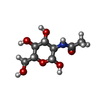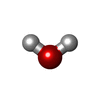[English] 日本語
 Yorodumi
Yorodumi- PDB-9n7e: Eptesicus fuscus ACE2 peptidase domain bound to VsCoV-a7 RBD complex -
+ Open data
Open data
- Basic information
Basic information
| Entry | Database: PDB / ID: 9n7e | ||||||
|---|---|---|---|---|---|---|---|
| Title | Eptesicus fuscus ACE2 peptidase domain bound to VsCoV-a7 RBD complex | ||||||
 Components Components |
| ||||||
 Keywords Keywords | HYDROLASE/VIRAL PROTEIN / Virus / HKU25 clade MERS-related coronaviruses / ACE2 / Glycoprotein / Receptor / Structural Genomics / Seattle Structural Genomics Center for Infectious Disease / SSGCID / HYDROLASE-VIRAL PROTEIN complex | ||||||
| Biological species |  Eptesicus fuscus (big brown bat) Eptesicus fuscus (big brown bat) Merbecovirus Merbecovirus | ||||||
| Method | ELECTRON MICROSCOPY / single particle reconstruction / cryo EM / Resolution: 2.5 Å | ||||||
 Authors Authors | Park, Y.J. / Veesler, D. / Seattle Structural Genomics Center for Infectious Disease (SSGCID) | ||||||
| Funding support |  United States, 1items United States, 1items
| ||||||
 Citation Citation |  Journal: bioRxiv / Year: 2025 Journal: bioRxiv / Year: 2025Title: ACE2 utilization of HKU25 clade MERS-related coronaviruses with broad geographic distribution. Authors: Chen Liu / Young-Jun Park / Cheng-Bao Ma / Cameron Stuart / Risako Gen / Yu-Cheng Sun / Xiao Yang / Mei-Yi Lin / Qing Xiong / Jun-Yu Si / Peng Liu / David Veesler / Huan Yan /   Abstract: Dipeptidyl peptidase-4 (DPP4) is a well-established receptor for several MERS-related coronaviruses (MERSr-CoVs) isolated from humans, camels, pangolins, and bats (1-6). However, the receptor usage ...Dipeptidyl peptidase-4 (DPP4) is a well-established receptor for several MERS-related coronaviruses (MERSr-CoVs) isolated from humans, camels, pangolins, and bats (1-6). However, the receptor usage of many genetically diverse bat MERSr-CoVs with broad geographical distributions remains poorly understood. Recent studies have identified angiotensin-converting enzyme 2 (ACE2) as an entry receptor for multiple merbecovirus clades. Here, using viral antigen and pseudovirus-based functional assays, we demonstrate that several bat merbecoviruses from the HKU25 clade previously thought to utilize DPP4 (7), employ ACE2 as their functional receptor. Cryo-electron microscopy analysis revealed that HsItaly2011 and VsCoV-a7 recognize ACE2 with a binding mode sharing similarity with that of HKU5 but involving remodeled interfaces and distinct ortholog selectivity, suggesting a common evolutionary origin of ACE2 utilization for these two clades of viruses. EjCoV-3, a strain closely related to the DPP4-using MERSr-CoV BtCoV-422, exhibited relatively broad ACE2 ortholog tropism and could utilize human ACE2 albeit suboptimally. Despite differences in entry mechanisms and spike proteolytic activation compared to MERS-CoV, these viruses remain sensitive to several broadly neutralizing antibodies and entry inhibitors. These findings redefine our understanding of the evolution of receptor usage among MERSr-CoVs and highlight the versatility of ACE2 as a functional receptor for diverse coronaviruses. | ||||||
| History |
|
- Structure visualization
Structure visualization
| Structure viewer | Molecule:  Molmil Molmil Jmol/JSmol Jmol/JSmol |
|---|
- Downloads & links
Downloads & links
- Download
Download
| PDBx/mmCIF format |  9n7e.cif.gz 9n7e.cif.gz | 176.6 KB | Display |  PDBx/mmCIF format PDBx/mmCIF format |
|---|---|---|---|---|
| PDB format |  pdb9n7e.ent.gz pdb9n7e.ent.gz | 134 KB | Display |  PDB format PDB format |
| PDBx/mmJSON format |  9n7e.json.gz 9n7e.json.gz | Tree view |  PDBx/mmJSON format PDBx/mmJSON format | |
| Others |  Other downloads Other downloads |
-Validation report
| Summary document |  9n7e_validation.pdf.gz 9n7e_validation.pdf.gz | 1.5 MB | Display |  wwPDB validaton report wwPDB validaton report |
|---|---|---|---|---|
| Full document |  9n7e_full_validation.pdf.gz 9n7e_full_validation.pdf.gz | 1.5 MB | Display | |
| Data in XML |  9n7e_validation.xml.gz 9n7e_validation.xml.gz | 36.2 KB | Display | |
| Data in CIF |  9n7e_validation.cif.gz 9n7e_validation.cif.gz | 54.4 KB | Display | |
| Arichive directory |  https://data.pdbj.org/pub/pdb/validation_reports/n7/9n7e https://data.pdbj.org/pub/pdb/validation_reports/n7/9n7e ftp://data.pdbj.org/pub/pdb/validation_reports/n7/9n7e ftp://data.pdbj.org/pub/pdb/validation_reports/n7/9n7e | HTTPS FTP |
-Related structure data
- Links
Links
- Assembly
Assembly
| Deposited unit | 
|
|---|---|
| 1 |
|
- Components
Components
-Protein , 2 types, 2 molecules AB
| #1: Protein | Mass: 89451.859 Da / Num. of mol.: 1 / Fragment: ectodomain Source method: isolated from a genetically manipulated source Details: GenBank XM_008154928.2 / Source: (gene. exp.)  Eptesicus fuscus (big brown bat) / Production host: Eptesicus fuscus (big brown bat) / Production host:  Homo sapiens (human) Homo sapiens (human)References: angiotensin-converting enzyme 2, Hydrolases; Acting on peptide bonds (peptidases); Metallocarboxypeptidases |
|---|---|
| #2: Protein | Mass: 29494.377 Da / Num. of mol.: 1 / Mutation: E366V Source method: isolated from a genetically manipulated source Details: GenBank BDI08829.1 / Source: (gene. exp.)  Merbecovirus / Strain: VsCoV-a7 / Production host: Merbecovirus / Strain: VsCoV-a7 / Production host:  Homo sapiens (human) Homo sapiens (human) |
-Sugars , 2 types, 11 molecules 
| #3: Polysaccharide | 2-acetamido-2-deoxy-beta-D-glucopyranose-(1-4)-2-acetamido-2-deoxy-beta-D-glucopyranose Source method: isolated from a genetically manipulated source #4: Sugar | ChemComp-NAG / |
|---|
-Non-polymers , 2 types, 164 molecules 


| #5: Chemical | ChemComp-ZN / |
|---|---|
| #6: Water | ChemComp-HOH / |
-Details
| Has ligand of interest | N |
|---|---|
| Has protein modification | Y |
| Sequence details | GenBank references are XM_008154928.2 for chain A and BDI08829.1 (with the E366V mutation) for chain B. |
-Experimental details
-Experiment
| Experiment | Method: ELECTRON MICROSCOPY |
|---|---|
| EM experiment | Aggregation state: PARTICLE / 3D reconstruction method: single particle reconstruction |
- Sample preparation
Sample preparation
| Component | Name: ACE2 peptidase domain bound to VsCoV-a7 RBD complex / Type: COMPLEX / Entity ID: #1-#2 / Source: MULTIPLE SOURCES |
|---|---|
| Source (natural) | Organism:  Merbecovirus / Strain: VsCoV-a7 Merbecovirus / Strain: VsCoV-a7 |
| Source (recombinant) | Organism:  Homo sapiens (human) Homo sapiens (human) |
| Buffer solution | pH: 7 |
| Specimen | Embedding applied: NO / Shadowing applied: NO / Staining applied: NO / Vitrification applied: YES |
| Vitrification | Cryogen name: ETHANE |
- Electron microscopy imaging
Electron microscopy imaging
| Experimental equipment |  Model: Titan Krios / Image courtesy: FEI Company |
|---|---|
| Microscopy | Model: TFS KRIOS |
| Electron gun | Electron source:  FIELD EMISSION GUN / Accelerating voltage: 300 kV / Illumination mode: FLOOD BEAM FIELD EMISSION GUN / Accelerating voltage: 300 kV / Illumination mode: FLOOD BEAM |
| Electron lens | Mode: BRIGHT FIELD / Nominal defocus max: 3000 nm / Nominal defocus min: 200 nm |
| Image recording | Electron dose: 60 e/Å2 / Film or detector model: GATAN K3 (6k x 4k) |
- Processing
Processing
| EM software | Name: PHENIX / Version: 1.18.2_3874 / Category: model refinement | ||||||||||||||||||||||||
|---|---|---|---|---|---|---|---|---|---|---|---|---|---|---|---|---|---|---|---|---|---|---|---|---|---|
| CTF correction | Type: PHASE FLIPPING AND AMPLITUDE CORRECTION | ||||||||||||||||||||||||
| 3D reconstruction | Resolution: 2.5 Å / Resolution method: FSC 0.143 CUT-OFF / Num. of particles: 578871 / Symmetry type: POINT | ||||||||||||||||||||||||
| Refinement | Stereochemistry target values: REAL-SPACE (WEIGHTED MAP SUM AT ATOM CENTERS) | ||||||||||||||||||||||||
| Refine LS restraints |
|
 Movie
Movie Controller
Controller





 PDBj
PDBj

